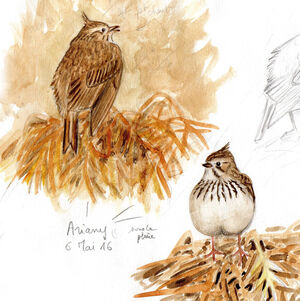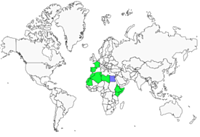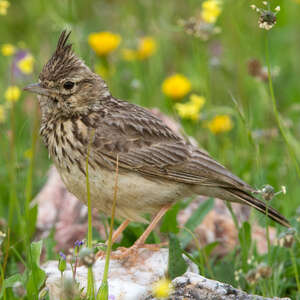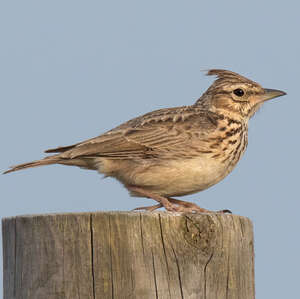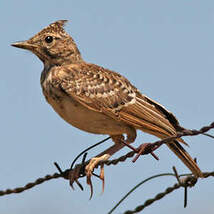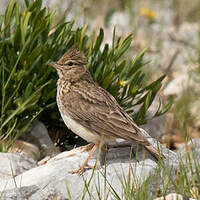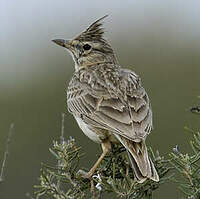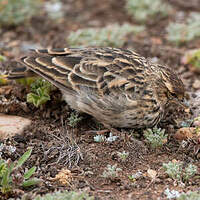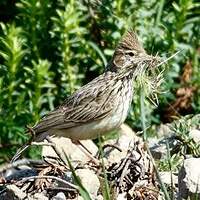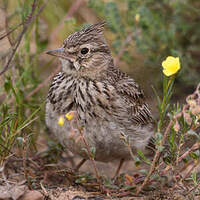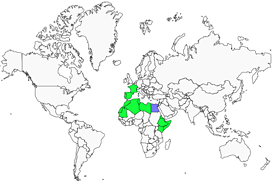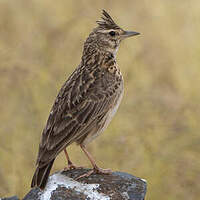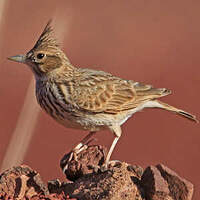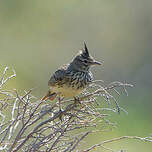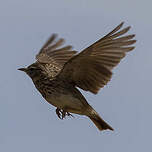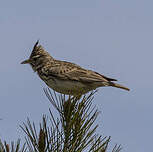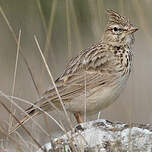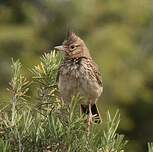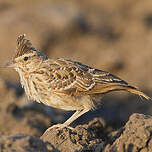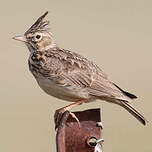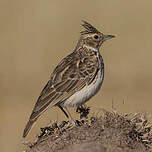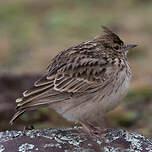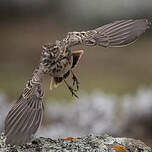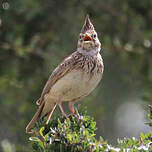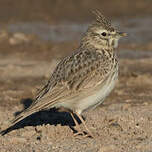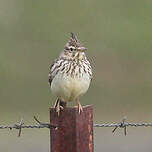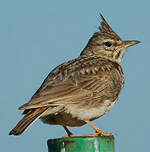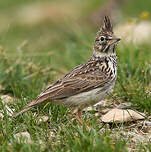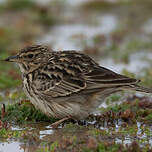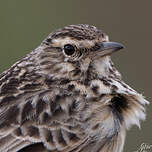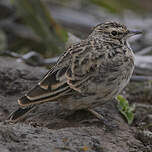Thekla's Lark
Galerida theklae - Cochevis de Thékla
Identification
Thekla's Lark is similar in size to the Crested Lark. Its silhouette is much more compact. It can be distinguished from this species by its shorter beak which has a straight or even slightly convex lower mandible. Both sexes are identical. Its crest is quite full and arranged in a more regular fan shape, which gives it a less pointed shape than the Crested Lark. The facial pattern is somewhat less clear, more diffused. Its upperparts are brownish and its underparts are off-white with well-marked dark streaks on the chest. The clarity and distribution of the chest streaks, the rufous tips of the rectrices and the gray tonality of the wing coverts, allow the experienced observer to easily distinguish it from the Crested Lark. Other criteria can only be ascertained when the bird is in hand, such as the external rectrices edged in cream-rufous contrasting with the neighboring feathers which are dark-brownish or the first primary remex which is longer than the primary covers. Its primary projection is shorter than that of the Crested Lark. Variations in some subspecies may complicate its identification. Juveniles can easily be recognized by their upperparts which are dotted with white-cream. Their crest is less developed.
Subspecific information 12 subspecies
- Galerida theklae theklae (Portugal, Spain, Balearic Is. and extreme s France)
- Galerida theklae erlangeri (n Morocco)
- Galerida theklae ruficolor (c and ne Morocco, n Algeria and n Tunisia)
- Galerida theklae theresae (sw Morocco and Mauritania)
- Galerida theklae superflua (e Morocco, n Algeria and e Tunisia)
- Galerida theklae carolinae (e Morocco through the n Sahara to nw Egypt)
- Galerida theklae harrarensis (e Ethiopia)
- Galerida theklae huei (sc Ethiopia)
- Galerida theklae praetermissa (s Eritrea to c Ethiopia)
- Galerida theklae ellioti (n and c Somalia)
- Galerida theklae mallablensis (s Somalia)
- Galerida theklae huriensis (s Ethiopia and n Kenya)
Foreign names
- Cochevis de Thékla,
- Cogujada montesina,
- cotovia-escura,
- Theklalerche,
- kövi pacsirta,
- Thekla's Leeuwerik,
- Cappellaccia di Thekla,
- lagerlärka,
- Krattopplerke,
- pipíška vavrínová,
- chocholouš vavřínový,
- Theklalærke,
- kivikkotöyhtökiuru,
- cogullada fosca,
- Kamblævirki,
- dzierlatka iberyjska,
- Teklas cīrulis,
- španski škrjanec,
- Короткопалый хохлатый жаворонок,
- コバシカンムリヒバリ,
- 短嘴凤头百灵,
- 短嘴鳳頭百靈,
Voice song and cries
Habitat
Behaviour character trait
This species is sedentary and territorial. During the breeding season, Thekla's Lark usually forms loose colonies. In winter it is found in small groups of about ten individuals which can mix with other species such as the Woodlark.
Dietfeeding habits
Reproduction nesting
Individuals can reproduce from the age of one. The two parents build the nest but the female takes on the greater part of the task as the male is more focused on territory surveillance.
The nest is located in an open meadow, simply concealed by a Brachypode rameux or Genêt scorpion plant. It is created with dry blades of grass and sometimes small stones are placed around it to help hold it up. The female lays 3 to 5 eggs in April. The incubation period is approximately 12 days and the young can fly at 15 days. A second laying in June is possible.Geographic range
Thekla's Lark of the nominal subspecies is present in the extreme southwest of Europe (Spain [including the Balearic Islands] Portugal and France [Aude and Eastern Pyrenees]) where it reaches the northern limit of its distribution area). 11 other subspecies inhabit northern Africa, from Morocco to northeastern Egypt, and 4 countries of the Horn of Africa, of which Ethiopia is a key part.
Threats - protection
IUCN conservation status
concern
in the Wild
threatened
evaluated
Thekla's Lark is not threatened as a species as its range is wide and it is locally common. Nevertheless, locally human activities and habitat destruction can put it at risk.
Sources of information
- IOC World Bird List (v13.2), Gill, F and D Donsker (Eds). 2023.
- Le guide ornitho : Le guide le plus complet des oiseaux d'Europe, d'Afrique du Nord et du Moyen-Orient : 900 espèces, Svensson, Mullarney, Zetterstrom
- Guide des oiseaux de France et d'Europe, Roger Tory Peterson, Guy Mountfort, P. A. D (Phill
- Les Oiseaux d'Europe et d'Afrique du Nord, Hermann Heinzel, Richard Fitter, John Parslow
- Les Oiseaux d'Europe, d'Afrique du Nord et du Moyen-Orient, Lars Jonsson
- xeno-canto, Sharing bird sounds from around the world,
Other sources of interest
 Specification sheet created on
03/08/2023 by Jean-Pierre Trouillas
Specification sheet created on
03/08/2023 by Jean-Pierre Trouillas partially rewritten on 00/00/0000 by Jean François
Translation by AI Oiseaux.net
published: 01-11-2010 - Updated: 19-12-2020
© 1996-2024 Oiseaux.net
- Accipitriformes
- Aegotheliformes
- Anseriformes
- Apodiformes
- Apterygiformes
- Bucerotiformes
- Caprimulgiformes
- Cariamiformes
- Casuariiformes
- Charadriiformes
- Ciconiiformes
- Coliiformes
- Columbiformes
- Coraciiformes
- Cuculiformes
- Eurypygiformes
- Falconiformes
- Galliformes
- Gaviiformes
- Gruiformes
- Leptosomiformes
- Mesitornithiformes
- Musophagiformes
- Nyctibiiformes
- Opisthocomiformes
- Otidiformes
- Passeriformes
- Pelecaniformes
- Phaethontiformes
- Phoenicopteriformes
- Piciformes
- Podargiformes
- Podicipediformes
- Procellariiformes
- Psittaciformes
- Pterocliformes
- Rheiformes
- Sphenisciformes
- Steatornithiformes
- Strigiformes
- Struthioniformes
- Suliformes
- Tinamiformes
- Trogoniformes

